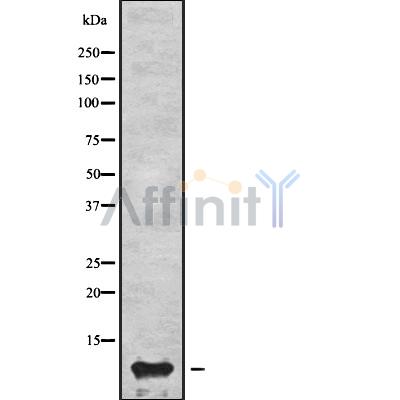APOC3 Antibody - #DF8054
| Product: | APOC3 Antibody |
| Catalog: | DF8054 |
| Description: | Rabbit polyclonal antibody to APOC3 |
| Application: | WB IHC IF/ICC |
| Reactivity: | Human, Mouse, Rat |
| Prediction: | Pig, Bovine, Horse, Sheep, Dog |
| Mol.Wt.: | 11 kDa; 11kD(Calculated). |
| Uniprot: | P02656 |
| RRID: | AB_2841411 |
Related Downloads
Protocols
Product Info
*The optimal dilutions should be determined by the end user. For optimal experimental results, antibody reuse is not recommended.
*Tips:
WB: For western blot detection of denatured protein samples. IHC: For immunohistochemical detection of paraffin sections (IHC-p) or frozen sections (IHC-f) of tissue samples. IF/ICC: For immunofluorescence detection of cell samples. ELISA(peptide): For ELISA detection of antigenic peptide.
Cite Format: Affinity Biosciences Cat# DF8054, RRID:AB_2841411.
Fold/Unfold
APOC3; APO C3; Apo CIII; Apo-CIII; APOC 3; ApoC III; ApoC-III; APOC3; APOC3_HUMAN; ApoCIII; Apolipoprotein C III; Apolipoprotein C-III; Apolipoprotein C3; ApolipoproteinCIII; MGC150353;
Immunogens
A synthesized peptide derived from human APOC3, corresponding to a region within the internal amino acids.
- P02656 APOC3_HUMAN:
- Protein BLAST With
- NCBI/
- ExPASy/
- Uniprot
MQPRVLLVVALLALLASARASEAEDASLLSFMQGYMKHATKTAKDALSSVQESQVAQQARGWVTDGFSSLKDYWSTVKDKFSEFWDLDPEVRPTSAVAA
Predictions
Score>80(red) has high confidence and is suggested to be used for WB detection. *The prediction model is mainly based on the alignment of immunogen sequences, the results are for reference only, not as the basis of quality assurance.
High(score>80) Medium(80>score>50) Low(score<50) No confidence
Research Backgrounds
Component of triglyceride-rich very low density lipoproteins (VLDL) and high density lipoproteins (HDL) in plasma. Plays a multifaceted role in triglyceride homeostasis. Intracellularly, promotes hepatic very low density lipoprotein 1 (VLDL1) assembly and secretion; extracellularly, attenuates hydrolysis and clearance of triglyceride-rich lipoproteins (TRLs). Impairs the lipolysis of TRLs by inhibiting lipoprotein lipase and the hepatic uptake of TRLs by remnant receptors. Formed of several curved helices connected via semiflexible hinges, so that it can wrap tightly around the curved micelle surface and easily adapt to the different diameters of its natural binding partners.
The most abundant glycoforms are characterized by an O-linked disaccharide galactose linked to N-acetylgalactosamine (Gal-GalNAc), further modified with up to 3 sialic acid residues. Less abundant glycoforms are characterized by more complex and fucosylated glycan moieties. O-glycosylated on Thr-94 with a core 1 or possibly core 8 glycan.
Secreted.
Liver.
Belongs to the apolipoprotein C3 family.
Research Fields
· Organismal Systems > Endocrine system > PPAR signaling pathway.
· Organismal Systems > Digestive system > Cholesterol metabolism.
References
Restrictive clause
Affinity Biosciences tests all products strictly. Citations are provided as a resource for additional applications that have not been validated by Affinity Biosciences. Please choose the appropriate format for each application and consult Materials and Methods sections for additional details about the use of any product in these publications.
For Research Use Only.
Not for use in diagnostic or therapeutic procedures. Not for resale. Not for distribution without written consent. Affinity Biosciences will not be held responsible for patent infringement or other violations that may occur with the use of our products. Affinity Biosciences, Affinity Biosciences Logo and all other trademarks are the property of Affinity Biosciences LTD.

